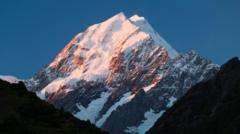Police in New Zealand have declared that they believe three climbers, who vanished days ago on Aoraki Mt Cook, are likely deceased. The climbers, identified as Kurt Blair (56) and Carlos Romero (50), both Americans, along with a Canadian national whose name has been withheld, were reported missing on Monday after they failed to catch their scheduled flight from the mountain.
Aoraki Area Commander Inspector Vicki Walker shared that authorities suspect the men fell while attempting to navigate a ridge. The search operations faced setbacks due to adverse weather, leading Walker to announce on Friday that the search would be scaled back. Utilizing helicopters and drones, rescue teams tried to locate the climbers, who embarked on their climb of Mt Cook on Saturday. Drone imagery revealed signs indicating the climbers' progression – including footprints and personal items such as clothing and energy gels thought to belong to them – at the base of the Zurbriggen Ridge.
Climbing Mt Cook via this route is classified as a Grade Four ascent, requiring considerable mountaineering experience and sound judgment, as outlined by Climb NZ. Both Blair and Romero were known as skilled climbers. The Silverton Avalanche School in Colorado honored Blair's legacy as a "cherished presence" within the San Juan Mountains, highlighting his calm demeanor and positive influence amidst the intense world of mountain guiding.
Colleagues remembered Romero, nicknamed Kique, as a well-respected guide and educator, expressing admiration for his passion in the climbing community. Originally hailing from Venezuela, Romero had worked for several years at the Lawrence Livermore National Laboratory in California. Out of respect for the family, police have chosen to keep the identity of the Canadian climber private.
Situated in New Zealand's South Island, Mt Cook stands at 3,724 meters (12,217 feet) tall and remains a sought-after challenge for climbers worldwide.
Aoraki Area Commander Inspector Vicki Walker shared that authorities suspect the men fell while attempting to navigate a ridge. The search operations faced setbacks due to adverse weather, leading Walker to announce on Friday that the search would be scaled back. Utilizing helicopters and drones, rescue teams tried to locate the climbers, who embarked on their climb of Mt Cook on Saturday. Drone imagery revealed signs indicating the climbers' progression – including footprints and personal items such as clothing and energy gels thought to belong to them – at the base of the Zurbriggen Ridge.
Climbing Mt Cook via this route is classified as a Grade Four ascent, requiring considerable mountaineering experience and sound judgment, as outlined by Climb NZ. Both Blair and Romero were known as skilled climbers. The Silverton Avalanche School in Colorado honored Blair's legacy as a "cherished presence" within the San Juan Mountains, highlighting his calm demeanor and positive influence amidst the intense world of mountain guiding.
Colleagues remembered Romero, nicknamed Kique, as a well-respected guide and educator, expressing admiration for his passion in the climbing community. Originally hailing from Venezuela, Romero had worked for several years at the Lawrence Livermore National Laboratory in California. Out of respect for the family, police have chosen to keep the identity of the Canadian climber private.
Situated in New Zealand's South Island, Mt Cook stands at 3,724 meters (12,217 feet) tall and remains a sought-after challenge for climbers worldwide.




















